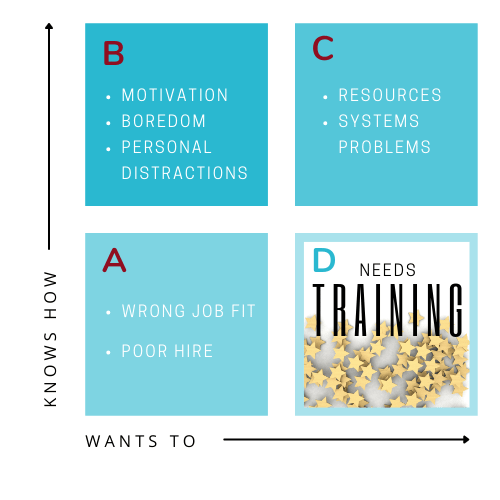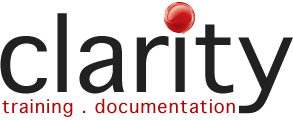Training Needs? Of course, I'd love it if every business problem was an indication that training is needed, but that's simply not true! And because I value the work I do, it's super important for me to make sure that I only design training where there's... you guessed it!... a training need. There's a big down-side in throwing training at a non-training issue, so it's worth investigating before investing.
So... how do you know?
When team members are not performing well in their roles, this Skill/motivation matrix is often helpful. I regularly use this to help guide these conversations with clients. This matrix is a simple and effective way to work out the best way forward, and whether or not training is the best solution.
The first step is to work out the two main driving factors for performance...
- 1Does the team member KNOW HOW to do the work? (Skill)
- 2Does the team member WANT to do the work? (Motivation)
Then work out where they fit on the matrix shown below. Read on for more detail about the implications of each quadrant.

Adapted from Jane Bozarth grid (2008) From Analysis to Evaluation: Tools, tips and techniques for trainers.
Original source unknown
Here's a brief summary of how to use the matrix...
Quadrant A:
The employee who lacks both the skills and the motivation to do the job they’ve been employed for. If you see the red flags of “attitude” in the first few weeks of Induction, then chances are that this is a case of a square peg in a round hole. Beyond the initial training, this person may not be worthy of a whole lot more investment. You’ll likely have some hard conversations and decisions to make.
Strategy… Close supervision and/or Performance management
Quadrant B:
This person knows how to perform in their role, but lacks interest in doing so. I commonly get requests for some “refresher” training for people who fit this category. Often this happens when someone has been in the same role for a long time. Be cautious about using re-training as a band-aid for this situation… it usually backfires! If the employee has been performing well and has demonstrated they have the skills for the job in the past, then training is not the solution. Chances are forcing them to complete refresher training will only add to their irritation with the situation. Explore the source of the motivation problem, before you decide on the best path forward.
Strategy… Find the root cause. They may be bored, and ready for a change of role, or a new challenge. Perhaps they're working for an ineffective leader. Or they may be feeling the impact of personal problems.
Quadrant C:
This employee has the skills. They know how to do the work, and they seem to be eager to do so, but the results tell a different story. If they have the skill and the will, but not the results, it’s most likely a problem that they don’t have control over. Something in your systems or resourcing is causing a hurdle or a roadblock that is holding back progress, and frustrating your employee. Or perhaps they’re spending a lot of their time helping others in the team. (In my experience it is very often the supervisor who has requested the training who needs the upskilling… sometimes they are the roadblock)
Strategy… Investigate the resourcing roadblocks
Quadrant D:
Now THIS… is my jam! This is where training needs exist. If you have a motivated worker who’s eager to learn, develop and perform in their role, but they have yet to develop the skills…
Strategy… TRAINING is the answer! Be careful though… get good advice on the style of intervention that is needed.
Training solutions are not a one-size fits all approach. At one end of the scale, sometimes a clearly laid out work instruction will be sufficient, at the other is a full blended bespoke learning programme. There are many different options, and it’s important to match the need with a solution that is both efficient and effective – and of course keeps your business strategy and training budget in mind. Considerations include things like:
Of course at Clarity, we have a robust Needs Analysis phase before we embark on designing training, so you can be assured we have a good handle on the issues. These are the foundations that underpin a solid training construction project.
If you’d like some help in figuring all of this out, I’m your gal! I’d love to chat about where you’re at and what solutions will drive the results you’re working towards.
Click here to book a FREE 30 minute audit via zoom. Let's get your team humming with the right skills and resources for the job.
